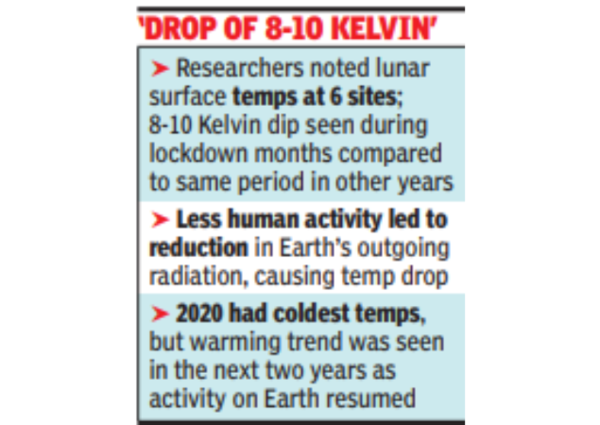BENGALURU: Indian researchers have found evidence that global Covid lockdowns of 2020 may have had an impact as far away as Moon. A study published in peer-reviewed Monthly Notices of the Royal Astronomical Society: Letters, accessed by TOI, reveals that lunar surface temperatures showed an anomalous dip during the strictest lockdown period of April-May 2020.
K Durga Prasad and G Ambily from Physical Research Laboratory (PRL) analysed night-time surface temperatures at six different sites-two locations of Oceanus Procellarum, Mare Serenitatis, Mare Imbrium, Mare Tranquillitatis, and Mare Crisium-on Moon’s nearside between 2017 and 2023. PRL director Anil Bharadwaj said: “…This is an important work by our group here. It’s quite unique.”

Using data from Nasa’s Lunar Reconnaissance Orbiter, the researchers have observed a consistent 8-10 Kelvin decrease in temperatures in Moon during the lockdown months compared to the same period in other years.
“We actually analysed data for 12 years. But used seven years data (2017 to 2023) in our study for uniformity-three years before the lockdown year, 2020 and the three years thereafter,” Prasad told TOI.
Researchers attribute this temperature drop to a reduction in Earth’s outgoing radiation during the lockdowns.
As human activity dramatically decreased, there was a significant reduction in greenhouse gas emissions and aerosols, leading to less heat being trapped and re-emitted by Earth’s atmosphere.
Researchers observed considerable temperature variations across sites and years. The lowest overall temperature was 96.2 K at Site-2 in 2020, while the highest of the lowest temperatures was 143.8 K at Site-1 in 2022. Generally, 2020 saw the coldest temperatures across most sites, with a noticeable warming trend in 2021 and 2022, once human activity had resumed on Earth.
“Moon acts as an amplifier of Earth’s radiation signature. This unique global event provided us with a rare opportunity to observe how changes in human activity on Earth can affect our nearest celestial neighbour,” Prasad explained.
“As an anomalous decrease in lunar night-time surface temperatures during the Covid lockdown period is observed, the effect of other possible factors such as solar activity and seasonal flux variation have also been investigated. Results show that none of these factors have any influence on the observed signature, thus supporting our findings to be only due to Covid lockdown,” the paper reads.
While the research presents an intriguing correlation, authors acknowledge that more data is needed to fully establish the link between Earth’s radiation changes and lunar surface temperatures. They suggest future Moon-based observatories could play a role in studying Earth’s climate and environmental shifts.
